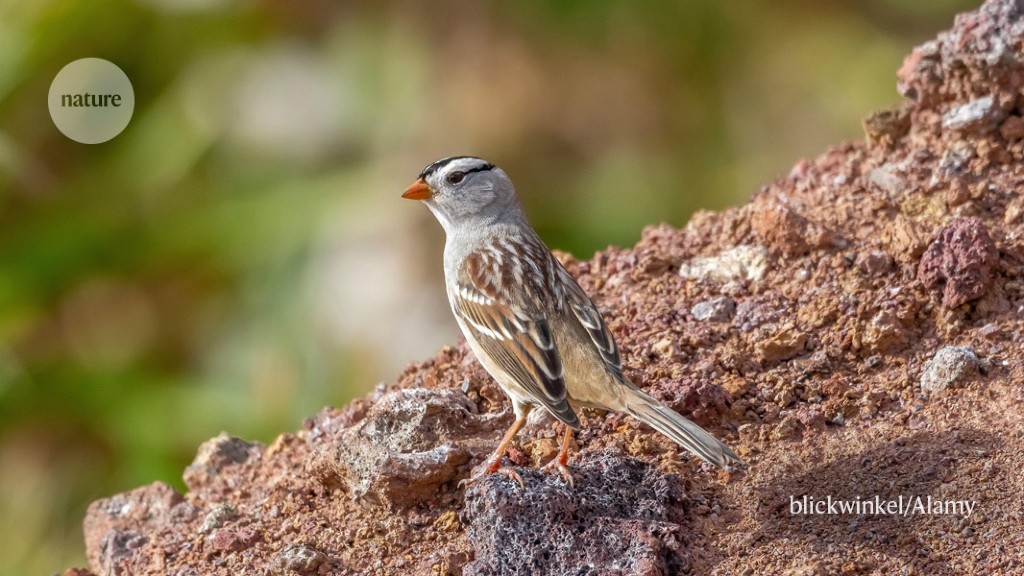This sparrow massively expands part of its brain in preparation for mating

The trick baffles researchers — but they are getting closer to understanding how the songbird does it

Gambel’s white-crowned sparrow (Zonotrichia leucophrys gambelii) is native to North America.Credit: blickwinkel/Alamy
Researchers have long known that areas of songbird brains that are responsible for singing grow during mating season and then shrink when the season is over. But one species, Gambel’s white-crowned sparrow (Zonotrichia leucophrys gambelii), does this on a scale that scientists are struggling to understand. A part of the male sparrow’s brain called the HVC grows from around 100,000 neurons to about 170,000 — nearly doubling in size — during the bird’s mating season.
Although how the bird pulls off this feat is still a mystery, scientists who presented data at the annual Society for Neuroscience meeting in Washington DC on 11–15 November are closing in on answers. They hope their findings might one day point to ways of treating anomalies in the human brain.
In most animals, when a brain region grows and shrinks, “frequently, it’s pretty detrimental on behaviour and function of the brain”, says Tracy Larson, a neuroscientist at the University of Virginia in Charlottesville who led the work. In particular, growth on this scale in mammals would cause inflammation and increase the pressure inside their skulls. But when it comes to the sparrows, “there’s something really fascinating about these birds that they can manage to do this and not have detrimental impacts”, Larson adds.
The skull as a ‘hard suitcase’
Larson’s research has so far hinted that the sparrow’s brain is using a slew of tactics to quickly form and then kill a large number of neurons. One question that Larson wanted to answer is how the sparrow’s brain shrinks dramatically at the end of mating season. So she and her colleagues tagged cells in and around the HVCs of male sparrows with a molecule called bromodeoxyuridine (BrdU), which can become incorporated into the DNA of dividing cells. They also used hormone supplements to simulate breeding season in the birds.
Towards the end of the simulated breeding season, they saw that BrdU-tagged stem cells near the HVC began to divide and develop into astrocytes — brain cells that support neurons in various ways. The tagged stem cells sat between the HVC and the hippocampus, a region deep in the brain involved in learning and memory. In the sparrows, the hippocampus also generates new neurons at certain times — in particular, before mating season, when the birds are migrating and need to increase the amount of brain power dedicated to navigation.
The birds seem to allocate space in their brains depending on which region needs it most at various points in the year. The skull is like “a hard suitcase”, Larson says. “If you are packing more neurons into the HVC, something’s gotta give somewhere else.”
The extra neurons in the HVC die at the end of mating season. Astrocytes in the same brain region clean up the mess, and die in the process. Stem cells outside the HVC then seem to replace those lost support cells. According to Larson’s observations, nearly all of the astrocytes in the sparrow’s HVC are replaced during this period.
The work is still preliminary, but it’s breaking new ground, says Jacques Balthazart, a biologist at the University of Liège in Belgium. People have quite extensively quantified the neurons that appear in the HVC, but not the astrocytes, he adds.
Larson hopes that the cycle of neurogenesis and degeneration will provide a model for studying depression in other animals, including humans. When the sparrow loses neurons, it displays signs of losing motivation to sing, which could be comparable to a type of depression. So how the bird gets out of this phase — the chemical or physical mechanisms that switch the HVC back towards growth — might offer clues to how to treat depression, Larson says. “How do these birds go from this depressed state to naturally being super excited?”
doi: https://doi.org/10.1038/d41586-023-03746-4
This story originally appeared on: Nature - Author:Anil Oza


















